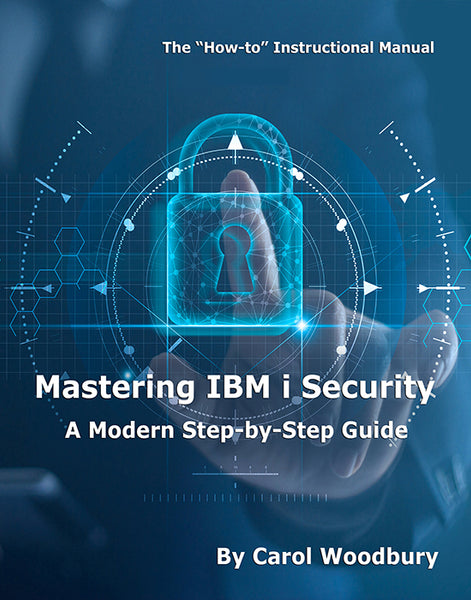There's more to security than just data privacy and confidentiality.
Recently, I was helping one of our clients compile a list of reasons to present to upper management as to why they needed to implement object-level security. One of the reasons I mentioned was data integrity. As we talked through this point, I realized that, with all of the emphasis on data privacy and confidentiality, the fact that appropriate access control settings can provide data integrity has been forgotten.
When people hear me talk about object-level security, some incorrectly assume that I mean that the data must be set to *PUBLIC authority of *EXCLUDE. But that's not the case. Data needs to be classified and secured appropriately. Just because data isn't classified as confidential or private doesn't mean that its access controls should be ignored. Even if the general public is allowed to view the data, it's rare that you would ever want the general user community to be able to change the data outside of the protection or bounds of the application logic. When the access control settings provide users with the ability to change the data through any interface, the integrity of the data comes into question. Most organizations want to ensure the integrity of their data. This means that the *PUBLIC authority of the data is set to no more than *USE authority.
Does this really happen, you ask? Yes, it does. I've helped several clients set all of their application files to be *PUBLIC *USE. The issue they wanted to address was not one of confidentiality or privacy. As long as the user had a profile on the system, users were allowed (by policy) to view all company data. So why did these clients feel that they had an issue that needed to be fixed? Because they were concerned about the integrity of their data--that is, given the access control settings on their files, anyone could have changed the data from outside of the application. So we used Policy Minder to help them set all of their application files to *PUBLIC *USE.
Whether you're trying to determine the state of your current configuration, about to start changing the settings, or simply want to ensure the system stays secured according to your policy, Policy Minder can help.
Determining Your Current Configuration
You can use Policy Minder to determine the state of your current object-level security implementation. Do your current access control settings provide data integrity (are they set to *PUBLIC *USE or less)? To find out, define a library and object template or a directory and object template. In the template definition, you can check the object's owner, the owner's authority, the authorization list, the *PUBLIC authority, the private authorities, and the auditing values. You can specify to check all of these values or just one of them. For example, for the first "wave" of discovery, you may want to determine the owner and *PUBLIC authority setting of all objects in the finance application and leave the private authority analysis for later. No problem. Simply define the attributes to analyze and run a compliance check. I recommend running the CHECK command and sending the results to a streamfile or outfile, allowing you to bring the list of the non-compliant objects into an Excel spreadsheet or to run queries for further analysis.
Fixing Your Current Configuration
After investigating the current configuration and determining how to accommodate outside processes so nothing breaks, you can use Policy Minder's FixIt function to make the changes to the object's security settings (e.g., set the files to *PUBLIC *USE.) FixIt provides documentation for auditors on exactly what was changed as well as a record of the previous value. Using Policy Minder to make security configuration changes provides a repeatable process should the changes have to be re-applied (such as when the vendor upgrades the application.)
Ensuring Your Configuration Remains Compliant
Once the new security configuration is in place, you'll want to make sure it stays in place. To do that, run regular Policy Minder compliance checks. If any settings are out of compliance, you can use FixIt to set them back so that they match your policy.
It's a Matter of Integrity
Remember, just because the data on your system isn't private or confidential doesn't mean that applying the appropriate object security is a waste of time. On the contrary, setting appropriate access controls will ensure the integrity of your data.















 Business users want new applications now. Market and regulatory pressures require faster application updates and delivery into production. Your IBM i developers may be approaching retirement, and you see no sure way to fill their positions with experienced developers. In addition, you may be caught between maintaining your existing applications and the uncertainty of moving to something new.
Business users want new applications now. Market and regulatory pressures require faster application updates and delivery into production. Your IBM i developers may be approaching retirement, and you see no sure way to fill their positions with experienced developers. In addition, you may be caught between maintaining your existing applications and the uncertainty of moving to something new. IT managers hoping to find new IBM i talent are discovering that the pool of experienced RPG programmers and operators or administrators with intimate knowledge of the operating system and the applications that run on it is small. This begs the question: How will you manage the platform that supports such a big part of your business? This guide offers strategies and software suggestions to help you plan IT staffing and resources and smooth the transition after your AS/400 talent retires. Read on to learn:
IT managers hoping to find new IBM i talent are discovering that the pool of experienced RPG programmers and operators or administrators with intimate knowledge of the operating system and the applications that run on it is small. This begs the question: How will you manage the platform that supports such a big part of your business? This guide offers strategies and software suggestions to help you plan IT staffing and resources and smooth the transition after your AS/400 talent retires. Read on to learn:
LATEST COMMENTS
MC Press Online